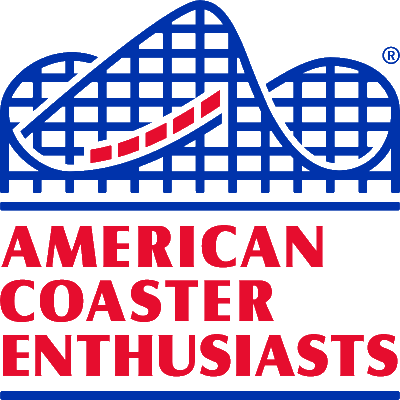ROLY COASTERS:
MAPPING AMERICAN ROLLER COASTERS
Revival: 1970-1990

After the almost tragic decline of coasters, hope soon dawned. The instantly popular King's Island Racer in Cincinnati, Ohio was built in 1972, and is credited with sparking the roller coaster revival of the late 20th century.
The butterflies of the first drop and the growing prevalence of steel coasters caught the public eye once again. American Coaster Enthusiasts (ACE) was also founded in 1978, inspiring coaster fans to help celebrate, preserve, and restore these rides.
Pictured: The logo of American Coaster Enthusiasts, a group founded during the revival era to celebrate roller coasters
The Revival era also encompassed a renaissance for the wooden roller coaster. Coaster designers of the renaissance often looked to the woodies of the Golden Age for ideas. Some of the first computer assistance available to designers helped pump out many wooden coasters that strongly resembled their long-gone predecessors, such as Grizzly at King's Dominion, Virginia.
The most impressive accomplishment during this era was the relocation of several roller coasters as a result of public support of preservation. San Antonio's Rocket was one of the first to be relocated, traveling over a thousand miles to reach Pennsylvania in 1980. Leap the Dips in Altoona, Pennsylvania also reopened in 1999 to be the oldest operating coaster at the time!
Pictured: Phoenix at Knoebels Amusement Resort in Pennsylvania. Previously called Rocket and located in San Antonio, Texas, Phoenix was one of the first coasters to be relocated.
The Nitty-Gritty: Further Insights

The revival era saw some slight growth in wooden coasters, but the steel era was already being ushered in as a result of coasters like the Matterhorn Bobsleds pioneering tubular steel. The movement towards preservation and restoration of older coasters also led wooden coasters to either be fixed or relocated, which contributed little to growth, but a lot to coaster history.

Steel coasters certainly saw a noticeable growth during the revival. Now that steel wasn't as burdened as during World War II, and people were looking for new amusements, this material became the primary material used for coasters. Steel also allowed designers to build higher and more extreme coasters, which leads us into the next age!

